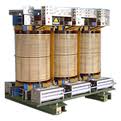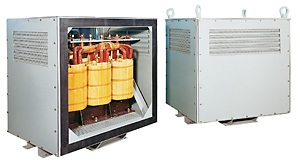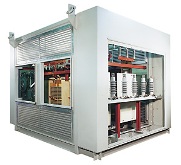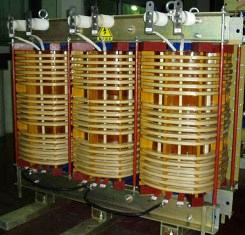Modern dry-type transformers and aggressive external factors
 Modern dry transformers are distinguished by a fairly high reliability in operation, but, like other electrical equipment, external factors affect their service life.
Modern dry transformers are distinguished by a fairly high reliability in operation, but, like other electrical equipment, external factors affect their service life.
Aggressive environmental factors
Consider aggressive external factors, as a result of which damage and failure of the transformer may occur.
Dry transformers are subject to various chemical and physical attacks, depending on the quality of the environment. The potential dangers are as follows:
-
humidity;
-
physical and chemical pollution;
-
wind.
Storage of dry transformers
During storage, the temperature of the transformer is equal to the ambient temperature. During this period, its insulation is exposed to moisture: penetration into the insulation and condensation on the surface, which can cause discharges ("overlaps") when voltage is applied. For this reason, it is recommended to store a dry transformer at a relative humidity of no higher than 90% and make sure that there is no condensation before using it.

Operation of dry transformers
A dry transformer during operation can be exposed to various aggressive influences.
High humidity
Although the operating temperature of the coils is higher than the ambient temperature, very high humidity can cause moisture to penetrate the coil material and deteriorate the insulation properties.
Conductive dust
Electrostatic fields attract dust particles deposited on the surface of the HV coils. This reduces the resistance to surface leakage currents, increasing the likelihood of transformer insulation overlap.
Volatile hydrocarbons: oil vapors, etc.
Electrostatically attracted hydrocarbon vapors can be deposited on the surface of the coils. Subsequently, under the influence of temperature, hydrocarbons can be chemically transformed to form semiconducting or conductive deposits. This can cause the insulation to close or disrupt the distribution of the electric field over the surface, contributing to the accumulation of conductive dust.
Chemical pollution
Some substances cause corrosion of insulating materials (its rate depends on humidity and temperature) and deterioration of dielectric properties.
Dust, sand, salt
The degree of influence of these factors depends on the presence of wind. The following options are available:
-
deterioration of electrical parameters: quality of contacts, resistance to leakage currents;
-
clogging of ventilators;
-
abrasive effect on the surface of insulators and reduction of surface resistance; • accumulation of conductive dust on the HV coils;
-
blocked vents.
Fine dust is hygroscopic, which further contributes to the formation of a conductive layer on the surface of the insulator.
Acceptable concentration
 For dry-type transformers operating in urban areas with industrial facilities or heavy traffic, as well as in areas unprotected from dust (except those near dust sources), the following restrictions should be observed:
For dry-type transformers operating in urban areas with industrial facilities or heavy traffic, as well as in areas unprotected from dust (except those near dust sources), the following restrictions should be observed:
-
relative air humidity, not more than 90%;
-
SO2 concentration, not more than 0.1 mg / m3;
-
NOx concentration, not more than 0.1 mg / m3;
-
concentration of dust and sand, not more than 0.2 mg / m3;
-
concentration of sea salt, no more than 0.3 g / m3;
Note: Recommendations are given in accordance with IEC 60721.
Taking into account these limitations, the expected service life of expensive transformers is preserved, which is tens of years.
Thermal conditions of the transformer
The thermal operating mode of the transformer is one of the most important factors influencing the aging of the insulation and, consequently, its operational life. It is recommended that the following conditions be observed to ensure adequate cooling, regardless of the size of the room and the degree of protection of the dry-type transformer (enclosure). These recommendations also apply to other types of electrical equipment.
Traction
The large volume of space above the transformer facilitates a better flow of heated air. In addition, the effectiveness of ventilation depends on its ability to remove air from the upper part of the room. To do this, the inlet should be located as low as possible and the exhaust as high as possible and on the opposite side.
The location of the air inlet (fan) above the transformer prevents hot air from escaping from it. This can cause the temperature of the transformer to rise above the permissible level. At best, thermal protection will work; in the worst case, if it is missing, overheating and premature aging of the insulation will occur.
Requirements for the room where the dry transformer is installed
Room dimensions
The purpose of effective room ventilation is to remove all heat generated by electrical equipment (transformers, motors, heaters, etc.).
It is assumed that in normal mode the device emits power losses P (kW).
To remove it with ventilation, you must:
-
cold air intake opening with an effective area S (m2), located in the lower part near the transformer (the effective area of the opening is its real area, minus all interferences - grids, valves, etc.);
-
a hot air outlet with an effective area S '(m2) located above on the opposite side, if possible above the transformer, at a height H (m) relative to the lower opening.
The area of the holes is determined by the formulas: S = (0.18 * P) / H, S '= 1.1 * S.
The space above the transformer must remain free up to the ceiling, except for connections.
These formulas are applicable when the equipment is installed at a height of up to 1000 m above sea level at an average annual temperature of 20 ° C.
If it is impossible to provide the aforementioned areas of openings for natural ventilation of the room, then forced ventilation must be applied using the installation:
-
in the lower opening — a supply fan with capacity Q (m3 / s), determined by power losses according to the formula: Q = 0.1 * P;
-
on the upper opening — exhaust fan with capacity Q '(m3 / s), determined by the formula: Q' = 0.11 * P.
If the area of only one of the holes is insufficient, it is allowed to limit the installation of the fan only on it.
Degree of protection
Depends degree of protection (IP) and the transparency of the mesh on the case walls, the required effective area of the vents can be quite large. For example, in an IP31 enclosure of a dry transformer, the eye perforation area is 50%.
The presence of other equipment in the room. If other equipment is installed in the room, when calculating the ventilation, the power P must include its losses at full load.
Transformer fan fans
The installation of fan transformer fans in no way reduces the requirements for ventilation of the room! When the fans are running, they also need cold air to flow into the room and hot air to escape.
Air conditioner around the transformer
Dust
Dust build-up on the transformer prevents proper heat dissipation. This is especially true for dusty industries such as those involving cement. Regular vacuuming (no blowing!) is required.
Atmospheric humidity
From the point of view of the ventilation of the transformer and the possibility of its overheating, air humidity is not a dangerous factor. However, when calculating the dimensions of the room and ventilation openings, the presence of heating elements that prevent the formation of condensation should be taken into account.
Knowing and observing certain rules and precautions to protect the transformer during its storage and operation from aggressive factors of any type is the key to the reliable operation of the transformer under conditions of design loads and controlled overloads.

